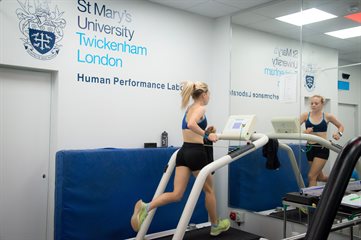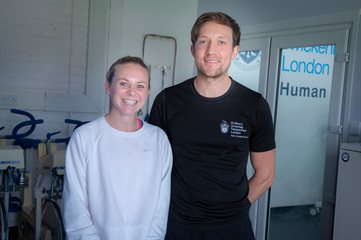By: Paul Hough (Senior Lecturer - Health and Exercise Science)


The World Athletics Championships Marathon takes place this evening in Doha at 23:59 (local time). The reason for this unusually late start is to avoid the scorching heat of Doha, which is not favourable conditions for running 26.2 miles! Despite the marathon starting at midnight the temperature is still likely to be around 33 °C! Competing in this heat significantly increases the physiological strain on the body and can lead to severe dehydration. This is problematic for athletes, as heat stress alone reduces athletic performance and can lead to heat illness, such as heat exhaustion.
The high temperature in Doha shouldn’t affect performances in track and field events as the Khalifa Stadium will be air conditioned and all sessions have been scheduled after 4pm. However, the marathoners will not have the luxury of competing in a climate controlled stadium! Therefore, most of the marathon competitors from cooler climates, such as the UK, will have completed some form of heat acclimation training before departing to Qatar.
UK athletes Charlotte Purdue and Tish Jones have prepared for the marathon by performing heat acclimation training sessions in our environmental chamber prior to the pre-championships training camp in Dubai.
What is heat acclimation training?
Heat acclimation training (HAT) is the artificial exposure to heat during exercise, for example exercising in a heated chamber. Training in the heat increases body (core and skin) temperature, induces profuse sweating and increases skin blood flow. All of these responses stimulate physiological adaptations, which improves the athlete’s tolerance to exercise in the heat and reduces the risk of heat illness.
Who does heat acclimation training?
HAT is routinely performed by athletes living in cold-moderate climates in order to prepare for an event in a warmer climate, such as Qatar. HAT improves thermal comfort (feeling less hot) and enhances aerobic exercise performance in warm-hot conditions. HAT is most commonly performed by endurance athletes, but it is beneficial to a variety of athletes. For example, I have worked with athletes’ from the following sports:
- Endurance sports (running, cycling)
- Motor sport: Formula 1, Formula 2, Dakar Rally, GT3 racing
- Tennis
- Football
- Boxing
- Ultra-endurance events (e.g. Marathon Des Sables and Badwater)
Does HAT have any other benefits?
There is limited evidence that HAT can improve athletic performance in moderate climates. For example, a study in trained cyclists demonstrated a 6% improvement in time-trial performance in cool conditions following 10 days of HAT. However, the effectiveness of training in the heat to improve performance in cool-moderate climates is debatable.
What does heat acclimation training involve?
HAT involves performing endurance exercise (running, cycling etc.) for extended periods (~60 minutes) at intensities between 50-70% VO2max. This is exactly what Charlotte was doing in our lab to prepare for the World Championships.
Typically, the positive adaptations (see below) of HAT occur within the first 4-6 days of training. However, the rate at which the adaptations occur varies between individuals. For example, the adaptations tend to occur faster in trained athletes.
Adaptations
↓Heart rate and autonomic nervous system habituation which redirects blood flow to the skin and muscles.
↑Thermal comfort (feeling less hot)
↓Reduced perception of effort
Earlier onset of sweating and ↑ sweat rate
Conservation of sodium chloride (salt)
The benefits of HAT are maintained for approximately 3 weeks, with the potential for individuals to be able to spend up to 3-4 weeks in cooler conditions before the need to readapt.
When should heat acclimation training be done?
Ideally HAT should be undertaken close to the event to maximise the benefits. However, re-acclimatisation following an absence of HAT can occur relatively quickly.
Summary
- It is beneficial for athletes preparing to compete in hot conditions to perform heat acclimation training (HAT) beforehand.
- HAT induces physiological adaptations, which reduces physiological strain and improves exercise capacity in the heat.
- HAT sessions should be performed at a moderate intensity, for around 1 hour/session.
- Prior to departure to the competition venue, athletes should aim to complete 4-7 HAT sessions, in an environment that simulates the same conditions as the competition venue.
Heat acclimation training is available at St Mary’s University, Twickenham.
References
Cheung, S., McLellan, T., & Tenaglia, S. (2000). The Thermophysiology of uncompensable heat stress. physiological manipulations and individual characteristics. Sports Medicine, 29, 329-359.
Costa, R., Crockford, M., Moore, J., & Walsh, N. (2014) Heat Acclimation Responses of an Ultra-Endurance Running Group Preparing for Hot Desert-Based Competition. European Journal of Sport Science, 14, 131-141.
Garrett, A., Rehrer, N., & Patterson, M. (2011) Induction and Decay of Short-Term Heat Acclimation in Moderately and Highly Trained Athletes. Sports Medicine, 41, 757-771.
Karlsen, A., Racinais, S., Jensen, M.V., Nørgaard, S.J., Bonne, T., & Nybo, L. (2015). Heat acclimatization does not improve VO2max or cycling performance in a cool climate in trained cyclists. Scandinavian Journal of Medicine & Science in Sports. 25, 269-76.
Nybo, L. & Lundby, C. (2016), CrossTalk opposing view: Heat acclimatization does not improve exercise performance in a cool condition. Journal of Physiology, 594, 245–247.
Poirier, M., Gagnon, D., Friesen, B., Hardcastle, S., & Kenny, G. (2015). Whole-Body Heat Exchange during Heat Acclimation and Its Decay. Medicine and Science in Sports and Exercise, 47, 390-400.
Racinais, S., Buchheit, M., Bilsborough, J., et al. (2014). Physiological and performance responses to a training camp in the heat in professional Australian football players. International Journal of Sports Physiological Performance, 9, 598–603.
Taylor, N., & Cotter, J. (2014). Heat Adaptation: Guidelines for the Optimisation of Human Performance. International Sportmed Journal, 7, 33-57.
Weller, A., Linnane, D., Jonkman, A., & Daanen, H. (2007) Quantification of the Decay and Re-induction of Heat Acclimation in Dry-Heat following 12 and 26 days without Exposure to Heat Stress. European Journal of Applied Physiology, 102, 57-66.
Willmott, A.G., Gibsona, O.R., Hayesa, B.M., & Maxwella, N.S. (2016). The effects of single versus twice daily short term heat acclimation on heat strain and 3000 m running performance in hot, humid conditions. Journal of Thermal Biology, 56, 59-67.